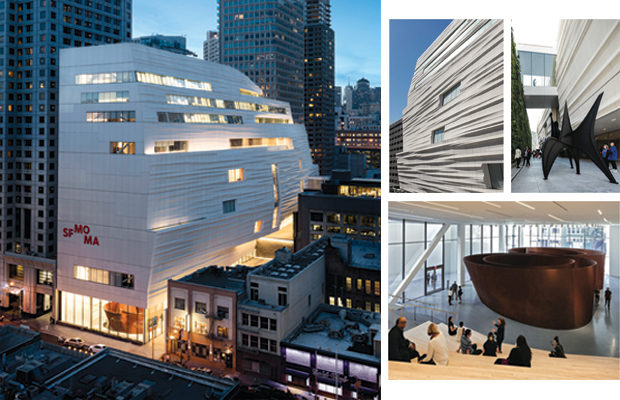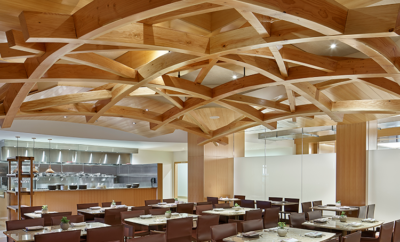 Snøhetta’s expansion of the new SFMOMA, which reopened in May. Detail of the Snøhetta expansion’s facade. The Pat and Bill Wilson Sculpture Terrace features an Alexander Calder sculpture and the living wall, designed by David Brenner of Habitat Horticulture. Photos by Henrik Kam, courtesy of SFMOMA. (4)
Snøhetta’s expansion of the new SFMOMA, which reopened in May. Detail of the Snøhetta expansion’s facade. The Pat and Bill Wilson Sculpture Terrace features an Alexander Calder sculpture and the living wall, designed by David Brenner of Habitat Horticulture. Photos by Henrik Kam, courtesy of SFMOMA. (4)
Architecture
A New Focus on Design in San Francisco
THE JUST-REOPENED SFMOMA ENHANCES THE GLOW OF THE GOLDEN CITY
GEOGRAPHY IS DESTINY, as Napoleon is rumored to have said just before invading Russia. The reopening of the San Francisco Museum of Modern Art—three years in construction and now the largest American museum of its kind—is emblematic of a dramatic shift in the city’s center of gravity from north to south of Market Street. SFMOMA’s bet on its South of Market location more than a quarter century ago has paid off. Thanks to greatly enhanced collections, a restaurant helmed by three-Michelin-star chef Corey Lee, and Snøhetta’s suave architecture, the reopened museum’s destiny seems predictable: expect record growth echoing that of the two decades since the museum moved into its distinctive building designed by Mario Botta in 1995, which is now incorporated within its expanded 460,000-square-foot quarters.
The harmonious marriage of the old and new buildings’ interiors helps account for the success of the design by Snøhetta, the firm founded by Norwegian architect Kjetil Trædal Thorsen and American architect Craig Dykers. The new building takes its decorative scheme of highly polished wood and stone, richly textured brick, and a high-contrast palette of black and white from the 1995 building, and retains the original lobby entrance with its dramatic oculus and grand staircase, albeit a staircase now reduced in size.
Not surprisingly, there are also major differences between the old and new buildings. The former was a jewel-box—iconic, monumental, and as inward-looking design destinations as the Hagia Sophia. The key to the new museum, by contrast, is its integration with the city beyond its walls. From the surrounding streets, the addition that has more than doubled the size of the museum is surprisingly unobtrusive, its ten-story height mediating between the low-rise Botta building on Third Street and the skyscrapers behind it. A serene new entrance off Howard Street takes the pressure off the museum’s former single entrance on bustling Third. Eschewing a signature silhouette, Snøhetta focused primarily on the needs of the exhibited art, designing flexible, elegantly proportioned galleries, and on the needs of its visitors to orient themselves within a ten-story structure that houses not just seven floors of galleries but an education center, conservation lab, auditorium, sculpture garden, terrace, restaurants, museum stores, and staff offices. Three points of orientation provide bearings: the two entrances and a multi-story “living wall,” a lush vertical garden designed by David Brenner and visible through windows and glass walls on the building’s north side.
It is axiomatic among museum professionals that nothing is more attractive to potential donor-collectors than a new building. The success of SFMOMA’s Campaign for Art, designed to mark its seventy-fifth anniversary in 2010 and its imminent expansion, surprised even the museum’s administrators. This success is apparent in the more than six hundred gifts in many of the initial installations occupying the museum’s 170,000 square feet of gallery space. More than three floors are currently devoted to two hundred additional, thematically arranged artworks from the Doris and Donald Fisher Collection, on long-term loan to the museum.
The Department of Design and Architecture’s dedicated galleries currently feature several exhibitions: Model Behavior presents Snøhetta’s first ideas for the new museum. Carve, Cast, Mold, Print showcases recent gifts in clever arrangements, as with a group of a dozen chairs by the diverse likes of Donald Judd, Ryuji Nakamura, Studio Drift, and Charles and Ray Eames. The department’s largest initial effort is Typeface to Interface: Graphic Design from the Collection, a celebration of designer Aaron Marcus’s gift to the museum and a primer for tracing the analog-to-digital course of visual communication since 1950. (Don’t miss the psychedelic graphics from San March Francisco’s Summer of Love!) Dutch designer Claudy Jongstra was commissioned to create the department’s first site-specific installation in the new building. She’s fashioned the paradoxically earthy and ethereal abstraction Aarde (meaning planet in Dutch) from the hand-dyed wool of heritage sheep she raised, subtly evoking notions of sustainability and self-sufficiency. The museum has also commissioned specially designed objects to commemorate its reopening, including jewelry from Marion Cage, Andrea Panico, Alice Roche, and Diana Schimmel—four far-flung architects turned designers.

ONE UNINTENDED EFFECT of the museum’s reopening is a renaissance for new art galleries nearby. Although astronomical, rents around the museum remain lower than those of the retail-oriented blocks surrounding Union Square, formerly ground zero for galleries. Two high-profile dealers, John Berggruen, the dean of San Francisco art dealers, and Larry Gagosian, the art world kingpin whose gallery empire stretches from Hong Kong to Geneva, opened spaces in adjacent buildings on Hawthorne Street, across Howard Street from the museum.

Like their art counterparts, galleries specializing in design are in geographic upheaval. The Design District at the base of Potrero Hill paved the way for the transformation of South of Market and remains the epicenter of modern and contemporary design in the city. For a classic modern sofa or chair, visit Almond and Company; for mid-century modern design and furniture, reliable purveyors include Robollo Home and De Angelis (formerly Monument, located in the nearby Mission District). The always intriguing Coup D’Etat not only shows its own furniture line and those of another dozen designers—some of whose output verges on conceptual art—but its staff periodically reinstalls the gallery’s entire showroom.

Following the trend south, the Museum of Craft and Design has moved to Dogpatch, San Francisco’s newest and most southerly arts neighborhood, already home to numerous galleries and studio buildings. The first permanent location for the twelve-year-old nonprofit is intended to diversify a program currently focused on thoughtful monographic exhibitions devoted to artists using craft material and found objects.
While many furniture and art galleries long ago departed for Design District digs south of Market, two of the most consistently satisfying remain in San Francisco’s original gallery district in the Jackson Square area—Hedge and Gallery Japonesque. Hedge is Steven Volpe and Roth Martin’s trendsetting gallery that has exhibited both little-known historical styles, such as French furniture of the 1940s, and museum-quality examples of long-established avant-garde furniture. Japonesque, a frequent participant in New York and London fairs, has shown both art and functional works—including Koichi Hara’s stunning cabinets embellished with gold leaf, glass, and copper—for thirty-five years.

Bucking the trend southward, a group of galleries has congregated since 2013 along Sacramento Street in the posh Presidio Heights/Pacific Heights area. Two standouts are Future Perfect, the partner of the vital New York gallery featuring its own furniture line as well as those of too-little-known designers including Piet Hein Eek and Pinch; and March, specializing in exquisite designer goods and art for the kitchen, pantry, and table.

Defying any recognizable real estate trends, two of the city’s premier galleries—Propeller and Velvet da Vinci—remain settled in homes off the beaten path. Propeller in Hayes Valley specializes in neo-modern designs ranging from Arktura’s Pac table, fabricated from a single sheet of white powder-coated steel, to Moooi’s Oase Tent sofa, a sleek modern design whose “naked” sofa can be dressed with twenty different tents. Velvet da Vinci, the city’s premier jewelry gallery, located in a former industrial loft on Polk Street near Broadway, specializes in singular offerings that are as much art as craft and design. It recently organized La Frontera, an exhibition of jewelry on the theme of politics, with the Museo Franz Mayer in Mexico City.

Robollo Home
This blurring of art and design practices reflects a significant loosening in today’s design outlook, a perspective grounded in events and attitudes that predominantly originated in San Francisco decades ago and subsequently reshaped American culture. These include the popularity of affordable, high-quality design attributable to pioneering retailers such as Chuck Williams; the revolutionary elevation of clay from the material of functional craft to that of ceramic sculpture in the hands of the influential Berkeley artist and teacher Peter Voulkos; and the creative reuse of historic architecture pioneered in Ghirardelli Square. One current emblem of this re-imagination of the past is the recent move by Heath Ceramics, the masters of mid-century ceramic tile and tableware, from the outskirts of Sausalito to a trendy SOMA/Mission District location. Closer to the firm’s retail customer base, its welcoming design and handsome wares epitomize today’s casually comfortable lifestyle—and its coffee bar serves up a first-rate cappuccino.

Detail of the Snøhetta expansion’s facade.











